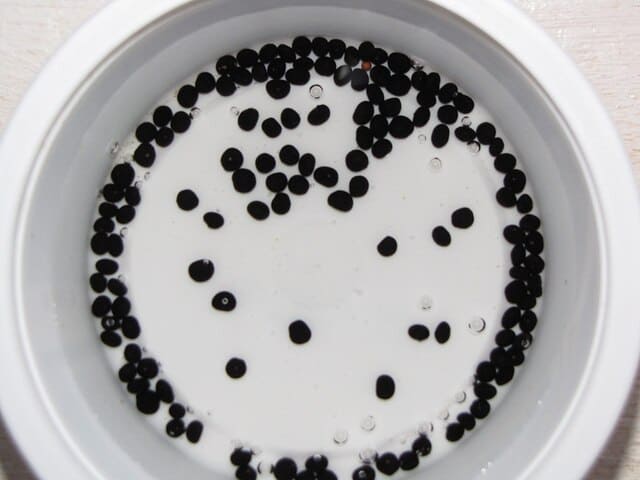Asparagus seeds can germinate at 68F (20C), however a suitable temperature for germination is from 86-122F (30-50C). Because asparagus seeds are very hard to crack, to sprout it faster we may need to use some heat and manual work. Let's see some different approaches now:
Way 1 (~3 days):
As the seeds have a hard shell, before germination you can soak them for 1 day & 1 night in warm water. A good water temperature is 122-140F (50-60C). You can get close to this temperature by mixing 3 parts boiling water with 2 parts cold water.
The process will look like this:
- At 5-6 AM: begin seed soaking, soak seeds in water at 122-140F / 50-60C
- At noon 11-12 AM: take seeds out, scrub them well, replace water 3 boils 2 colds at 122-140F / 50-60C
- At 5-6 PM & 11-12 PM: take seeds out, scrub well, replace water 2 boils 2 colds at 104-122F / 40-50C
The next day:
- At 5-6 AM: take seeds out of water, wash them well to dissolve the sour smell of seed preservatives. Some preservatives may have a yellow coating. After washing, the seeds will now reveal their black color (the natural color of asparagus seeds). Rinse seeds well, then place them in a muslin bag, cheese cloth or some clean fabric.
- Every 2-3 hours, steep the seed bag in warm drinking water 86-95F (30-35C). This is to keep the moisture and temp at 77F (25C).
- After 6-8 times doing this steeping (could be up to 18-24 hours), some seeds will crack out a little tiny white root. We can then take those germinated seeds to pots for further nursing and growing.
It's better to do this on the weekend so you have two full days to babysit the seeds. Another way we can do is:
Way 2 (~3 days):
Step 1: Wash & Soak the Seeds
Prepare some lukewarm water around body temperature 98.6F / 37C. Let seeds sit in the water for about 2 hours. After that, rinse them under running water (no scrubbing needed). If the seeds contain coated preservatives, washing and rinsing them will dissolve the coating and reveal the black color of asparagus seeds.
After washing and rinsing, we'll continue to soak the seeds in warm water. For smaller seeds, soaking for 1 day is good enough. For larger seeds, give them 1.5 days because of the larger seed size. You can replace the water every 6 hours to maintain a good warm temperature.
When soaking is done, you can rinse the seeds. Sit them there for 20mins for breathing. Then, we can move on to the next step which is:
Step 2: Germinating the Seeds
To germinate the soaked seeds, we can prepare:
- A container to hold seeds
- A dark color piece of fabric
- Some cotton
- Boiling water
Firstly, use tweezers to dip the fabric piece and cotton in hot boiling water for sterilization. This helps kill of bacteria that could ruin the germ. After steeping, take them out and let their temp cool down.
After cooling down, absorb some warm water into the cotton. Remember not to soak it too wet. Then, place the cotton out evenly at the bottom of the container. Place the dark color fabric on top. Put seeds in and fold the fabric over the seeds. Finally, place the container in a dark place (like a cupboard) without direct sunlight.
Every 4-6 hours, we can take the container out to sterilize the cotton, fabric and wash the seeds. Lots of time, asparagus germ get rotted because of little bacteria messing around.
So to sterilize the cotton and fabric piece, we'll steep them in hot boiling water again. For the seeds, place them on a screen and wash them under a running faucet. This helps minimize contact between seeds or between our hands and the seeds, which may damage little germ without knowing.
After repeating this step for 3-4 times a day, in about 3 days, seeds will germinate.
Thanks:
Share or pin this post!
(to be created)

